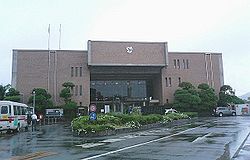Munakata, Fukuoka
This article needs additional citations for verification. (October 2011) |
Munakata
宗像市 | |
|---|---|
 Munakata City Hall | |
 Flag  Emblem | |
 Location of Munakata in Fukuoka Prefecture | |
 Munakata Location in Japan | |
| Coordinates: 33°48′N 130°32′E / 33.800°N 130.533°ECoordinates: 33°48′N 130°32′E / 33.800°N 130.533°E | |
| Country | Japan |
| Region | Kyushu |
| Prefecture | Fukuoka Prefecture |
| first official recorded | 391 AD |
| City Settled | April 1, 1981 |
| Government | |
| • Mayor | Misako Izu (from May 2018) |
| Area | |
| • Total | 119.66 km2 (46.20 sq mi) |
| Population (October 1, 2016) | |
| • Total | 96,728 |
| • Density | 810/km2 (2,100/sq mi) |
| Time zone | UTC+09:00 (JST) |
| City hall address | 1-1-1 Tōgō, Munakata-shi, Fukuoka-ken 811-3492 |
| Website | www |
| Symbols | |
| Flower | Japanese lily |
| Tree | Camphor laurel |
Munakata (宗像市, Munakata-shi) is a city in Japan, located in Fukuoka Prefecture, in the north Chikuzen region of the prefecture. The city was founded on April 1, 1981. As of October 1, 2016, the city has an estimated population of 96,728 and a population density of 810 persons per km². The total area is 119.66 km².
Efforts have been made to inculcate Japan-South Korea friendship, and also friendship with New Zealand in recent years.
History[]


The origin of the name Munakata is said to be from "Minokatachi" or "Minokata" from the enshrinement of three Munakata goddesses, descended from sword of Susanoo-no-Mikoto and mentioned in the Kojiki.
The area has prospered from trade with China and Korea from ancient times. It has been a World Heritage Site (Okinoshima) at Munakata Shrine. Munakata Shrine specifies itself as the territory of the god of Kyūshū during the Asuka period — ranging from Onga in the east, south to Wakamiya and Miyata, and Shingū in the west. During the age of civil wars a daimyō with leading Shinto priest and of Munakata Shrine established castle (Mount Jo). Through this, Munakata, Onga and Kurate were protected from invasion by other daimyos such as Tachibana Dōsetsu and the Ōtomo clan. There are also ghost stories connected with the area since the arose.
On April 1, 2003, Munakata absorbed the town of Genkai (from Munakata District) to create the new and expanded city of Munakata.
On March 28, 2005, the village of Ōshima (also from Munakata District) was absorbed into Munakata.
In the earthquake on March 20, 2005, damage was done in various parts of the city. The quake registered just under five on the Japan Meteorological Agency seismic intensity scale.
Akama[]
Akama (赤間) is a historical district and city center of Munakata. It contains rows of old houses belonging, along with the original Akama hotel and two now-ruined castles: Hakusan Castle and Tsutagadake Castle. The Shinto priest and founder of Munakata Shrine was a local military leader in medieval times. It is also connected to the period in history when Saigō Takamori and Takasugi Shinsaku were in conflict with the national government.
The main JR Kyūshū train station in Munakata is called Akama, and is a part of the Kagoshima Main Line. The city is also served by the Kyōikudaimae and Tōgō JR stations.
Sports facilities[]
- Global Arena, which has hosted the Sanix World Rugby Youth Invitational Tournament since 2000
- Genkai Ground, which hosts the Munakata Sanix Blues rugby team
External links[]
| Wikimedia Commons has media related to Munakata, Fukuoka. |
- Munakata City official website (in Japanese)
- Munakata, Fukuoka
- Cities in Fukuoka Prefecture
